Behr Color Codes
I know that Behr color codes were discussed on here before, but I saw one code that I cannot find the corresponding color for. The code on my paint can was YL.
I have the following:
AXL=Permanent Yellow
BL=Black
CL=Yellow Oxide
DL=Phthalo Green
EL=Phthalo Blue
FL=Red Iron Oxide
IL=Brown Iron Oxide
JL=Carbazole Purple
KXL=White
LL=Raw Umber
RL=Permanent Red
TL=Medium Yellow
VL=Magenta
YL=
Does anyone know what YL is? Are there any other color/code combos that I'm missing?
Thanks,
Lou
Comments (69)
Lori A. Sawaya
6 years agolast modified: 6 years agoIn my mind the colors should be CMYK, plus maybe RGB....but no.
CMYK is Cyan, Magenta, Yellow and Black ink. Printer's and graphic design ink. The K stands for Key as in key color.
RGB refers to mixing red, green and blue channels of light to create a range of other colors of light.
And as you've already figured out, neither one has anything to do with paint color formulas or color for the built environment.
Visually, the three yellows look alike to me, but now I know there are features that separate them.
YES! That's just one more layer of substance uncertainty, you can't tell what an individual colorant is going to do when mixed with other colorants and a base until you mix it, let it dry and look at it.
Color is made using CIEL*a*b values. Color is defined, described and communicated using the color notations hue, value, chroma and LRV. Color data values and color notations are ascertained by measuring color when it is DRY.
The "code to color" that everybody is looking for is not CMYK, RGB or a list of colorant abbreviations. It's CIEL*a*b* and Hue/Value/Chroma/LRV color notations.
And you're not going to find them on the first page of a Google search all spelled out and explained how they work and how they practically apply to specifying color for the built environment. It's information only a very few, select color experts know and have.
But you CAN find it if you dig hard enough.
Paint sales at Home Depot
6 years agoIf you have seen the Glidden color nomenclature, Hue/Value/Chroma/LRV are plainly stated after the given name. I can bring up the formula by either its made up name, or the physical description nomenclature. Behr does not do the same, at least for distribution amongst the associates in the HD stores.
Yes, only dry colors are read. Very simple reason, at least amongst water soluble "latex" paints: the wet latex,acrylic,urethane resins all have a distinct white color which totally disappears as the resin dries. All the water based paints darken somewhat when dry. The deep base do it more dramatically due to the fact that there is NO white pigment in a "deep base" paint, so the inherent whitish look is more obvious.
There are actually 4 yellow colors in the Home Depot tint machines: light yellow, medium yellow, YL high hide yellow and yellow oxide. The differences are quite obvious when seen together. All will result in dull greens when mixed with lamp black, which acts like blue.
Related Discussions
Behr Pale Wheat or Behr Raffia Ribbon
Q
Comments (5)I chose the pale wheat, and am now "cutting in." I also did one section of a wall and it looks beautiful. When I figure out how to post pictures I'll post some....See MoreBehr interior paint color Song of Summer - nice lite yellow
Q
Comments (3)Will post some pictures when I can, can't find the cord to the camera at the moment - everything a mess from moving stuff to paint. This was a semi-gloss job, being in the kitchen I wanted a tough finish. Been about a week now I guess since the color has been on the walls and love it - as the light shifts it looks more golden buff, other times a creamy lemon. Read on the Internet that a STRONG yellow color, while warm and appealing, can also be intensely irritating to people (more people fight in yellow rooms and restaurants use bright yellow on the walls to encourage people to eat and go!) But I could happily sit in my kitchen now for hours....See MoreIs Behr Silver Drop a new color or older color?
Q
Comments (4)They "discontinue" paint chips to make room for new colors. But they still have all the formulas if you know the name. I happened upon it when I was looking through some older paint sample brochures from HD trying to find a nice pale gray. I went to find the chip at the store and the paint guy said they don't carry it but he could make me a sample....See MoreWhat color white trim contrasts well with Behr swiss coffee paint?
Q
Comments (6)I want to use Ultra pure white behr time color, so I can have some contrast but want to make sure the color hue family wont be off? Not off at all. Plenty of contrast in general but most importantly in terms of Chroma. Honestly, there aren't many colors Ultra Pure White doesn't work with because of its high Value and low Chroma. In a word, nuance. When we consider a color's lightness and colorfulness at the same time, that's called nuance and I think it's what makes UPW such a pretty color of white. Every brand (I think) has a color named Swiss Coffee. IMO, BEHRs is the prettiest. It's right on the edge of being an off-white and a light near neutral. I have a post about it here. https://thelandofcolor.com/swiss-coffee-12-by-behr/...See MorePaul Hartzell
6 years agoI went through the Home Depot colorant list and this is the current tint list by name:
BL = Lamp Black
KXL = Titanium Dioxide[white]
JL = Carbazole Violet
VUL = High Hide Violet
VL = Quinacridone Violet
RUL = High Hide Red
RL = Permanent Red
FL = Red Iron Oxide
YL = High Hide Yellow
TL = Medium Yellow
AXL = Permanent Yellow
CL = Yellow Oxide
DL = Phthalo Green
EL = Phthalo Blue
IL = Brown Iron Oxide
LL = Raw Umber
It would seem that YL should be called YUL, but it is what it is.Paint sales at Home Depot
6 years agoYL and JL are the two latest additions to Behr tints. YL was added when we got the guaranteed one coat Marquee line of paints. It definitely really covers better than the conventional yellows, which have always been notorious for bad coverage and fading.
Jl was added because there were certain colors which just could not be achieved with the other colorants.
Francesca Davis
5 years agoI'm interested in understanding the color codes because I'm not always satisfied with the exact shades offered. If I know what's being used then I can adjust it.
Jennifer Hogan
5 years agoFrancesca, I couldn't agree more. If you are really interested in understanding the colorants go to the art supplies at Michael's and buy a sampler of oil or acrylic paints and you will find most of the colors on the Behr colorant list. This isn't some magic trick - it is simply mixing colorants with a base and they are the same colors as artists use to paint pictures.
Some sites will have the colorants shown with a picture of the color in a gradient mix with white so you can see the full strength color and what it becomes as you mix it with white. They also often rate the opaqueness/transparancy of the colors.
Reds, yellows and violets are naturally more transparent pigments. My guess is that the high hide versions of these colors are somewhat de-saturated offering a higher opacity, but without playing with them I can't be certain.Lori A. Sawaya
5 years agolast modified: 5 years agoI'm interested in understanding the color codes because I'm not always satisfied with the exact shades offered. If I know what's being used then I can adjust it.
The reason so many people believe there is some kind of control to be had in the recipe to mix color is because that's the only part of color they've ever been exposed too.
After all, it's the formula that's stuck on the side of every paint can.
I get it. It's all you know. It's all you've seen.
But you don't know what you don't know.
Where do you think the formula comes from?
How do you think those color recipes are created?
There isn't a workshop of elves somewhere tinkering with colorants from Behr or samplers from Michael's carefully mixing and tweaking one color at a time and then writing that magical formula they figured out down on a grand parchment scroll to be handed off to the Grand Poobah of paint.
The genesis of paint colors is NOT the formula.
It's mathematical modeling. Specifically CIE L*a*b* values.
And unlike lists of colorant codes that are unique to each brand, CIE L*a*b* values are a universal standard. They apply CONSISTENTLY to all colors across all brands - actually all industries not just paint.
They're also easy to find.
You can look them up on line at easyrgb dot com.
Also, all the apps for hand-held colorimeters like Color Muse, NIX and ColorReader Pro will display reasonably accurate CIE L*a*b* values which means you can get a CIE L*a*b* value for anything just by measuring it with a device.
A CIE L*a*b* value is the genesis of every tangible color.
I can "tweak and adjust" most colors in less than a minute - without spending a dime. Understanding the channels of CIE L*a*b means I can manage (tweak) color by hue, lightness, chroma, redness, greeness, blueness and yellowness - every dimension of color.
Granted, it's not as much fun as buying or acquiring a bunch of colorants and then spending hours mixing color and going to the paint store to buy testers then coming home and painting those on boards and staring at them for a while and then possibly repeating that process a few more times.
That process can be pricey, require a lot of back and forth and be super repetitive and you may or may not end up with an actual solution - but I admit it can be fun.
Paint sales at Home Depot
5 years agoIf you don't have one, you should buy a color wheel. It explains the relationship of the colors to one another and will show what results when they are mixed together. Walmart has them online for several dollars.
Jennifer Hogan
5 years agoI just bought samples from Behr of their color Cappuccino Froth.
I wanted to see it both in the matte and eggshell sheen.
The Matte Sample was Behr Premium Plus Medium Base with a formula of2 CL
2 IL
48 KXL
44 LL
The Eggshell Sample was Behr Marquee Ultra Pure White base9.5 BL
14 CL
8.5 IL
Here comes frustration: Neither color is all that close to the swatch or Easy RGB.My reading Marquee - #CCC4B8 CIE-L*ab = 79.488 0.715 7.014
The hexadecimal color code #ccc4b8 is a light shade of brown. In the RGB color model #ccc4b8 is comprised of 80% red, 76.86% green and 72.16% blue. In the HSL color space #ccc4b8 has a hue of 36° (degrees), 16% saturation and 76% lightness.
My reading Premium Plus - #D3CABD CIE-L*ab = 81.710 0.898 7.600The hexadecimal color code #d3cabd is a light shade of brown. In the RGB color model #d3cabd is comprised of 82.75% red, 79.22% green and 74.12% blue. In the HSL color space #d3cabd has a hue of 35° (degrees), 20% saturation and 78% lightness.
My Reading Swatch = #D1C6BC CIE-L*ab = 80.502 2.121 6.378The hexadecimal color code #d1c6bc is a light shade of orange. In the RGB color model #d1c6bc is comprised of 81.96% red, 77.65% green and 73.73% blue. In the HSL color space #d1c6bc has a hue of 29° (degrees), 19% saturation and 78% lightness.
EASY RGB color match = #D0C7BD CIE-L*ab = 80.463 1.563 6.404The hexadecimal color code #d0c7bd is a light shade of brown. In the RGB color model #d0c7bd is comprised of 81.57% red, 78.04% green and 74.12% blue. In the HSL color space #d0c7bd has a hue of 32° (degrees), 17% saturation and 78% lightness. This
Behr color experts did say that there can be slight variations in the color based on which line you select, but assured me that the color difference is minimal and not all that noticeable. The one degree in hue difference and the 2 degree light difference is probably acceptable, but add 4% saturation to the mix and I have moved from that slightly red taupe to a dead neutral that next to my orange teak is appearing lifeless.
Experience with mixing paints tells me that the addition of the Lamp Black is what is making this go dead. I will most likely have another sample done in the PP Ultra and reduce the yellow oxide by 1 / 384th and see if that gets me closer to goal.Paint sales at Home Depot
5 years agoJenifer,
I am not privy to the logic of why Behr changes formulas between their products, but I can give you a few hints: first, Marquee has at least 20 % more titanium dioxide in it, as compared to the Premium Plus and Premium Plus Ultra. These later will normally share the same formula,
because they have the same amount of titanium white pigment.. Marquee will of necessity have more colorant to overcome all that extra white pigment. Also notice that the Marquee moved from a Medium Base to an Ultra Pure White Base. Again, much more white in the UP White over the Medium Base.
Marquee's biggest selling point is that its' dedicated color palette will cover any substrate color in only one coat. To this extent, the addition of Lamp Black will significantly improve coverage, as do all the "organic" colorants, such as the Brown Oxide which is also in the Marquee formula. The organic colorants block light much better than the "inorganic" primary colors. Unfortunately, they also dull colors.
It is my observation that there are very few of what I would call bright, clear colors in Marquee. Clear, bright colors just do not cover well, thus you don't see any pastels in Marquee.
I agree with you that Lamp Black is what you object to and what is causing the problem.
There is a tendency in the color industry to use "full spectrum" tinting, which avoids the use of the organic colors, and for sure Lamp Black, to dull colors, but rather to use the opposite colors of the color wheel to do whatever dulling is desired. I believe Marquee is more interested in high hiding coverage, than clarity of color.
Jennifer Hogan
5 years agoThank you Dave - Titanium white is very opaque and will require a lot more pigment to get rich colors. Hence the addition of lamp black to darken, but it will not enrich.
Lori A. Sawaya
5 years agolast modified: 5 years agoCappuccino Froth
Matte Sample was Behr Premium Plus
CIELAB = 81.710 0.898 7.600
Eggshell Sample was Behr Marquee
CIELAB = 79.488 0.715 7.014
My Reading Swatch
CIELAB = 80.502 2.121 6.378
EASY RGB
CIELAB = 80.463 1.563 6.404
The CIELAB values are the only data values that are usable.
None of the other values matter or are applicable to architectural coatings.
HSL, HEX Codes and RGB values are about mixing channels of light to make color, like on a computer monitor. They are not relative to how we see and perceive color in real life.
If you want to compare color based on hue angle/degree, you need to work in the LCh color space. It works a lot like the Munsell color space.
Because Munsell was the template for LCh and also CIELAB.
Lori A. Sawaya
5 years agolast modified: 5 years agoNeither color is all that close to the swatch or Easy RGB
Results based on the data values alone -no visual comparison- shows us that the colors are actually very close.
You don't say where your values came from, the illuminant or the observer.
So I'm assuming Illuminant D65 and 2 degree observer because that's the common standard for architectural coatings.
When we convert CIELAB to LCh so we have a value that does apply to architectural color and is easy to mentally decipher, this is what it looks like:
Matte Sample was Behr Premium Plus
CIELAB = 81.710 0.898 7.600
L = 81.710 C = 7.653 h° = 83.261
Munsell 0.11 Y 8.04/1.13
Eggshell Sample was Behr Marquee
CIELAB = 79.488 0.715 7.014
L = 79.488 C = 7.050 h° = 84.179
Munsell 0.50 Y 7.81/1.03
My Reading Swatch
CIELAB = 80.502 2.121 6.378
L = 80.502 C = 6.721 h° = 71.605
Munsell 7.26 YR 7.91/1.13
EASY RGB
CIELAB = 80.463 1.563 6.404
L = 80.463 C = 6.592 h° = 76.284
Munsell 8.39 YR 7.91/1.06
When we plot the data on the Color Strategist Color Wheel because that's the only way to illustrate LCh and compare color based on hue angle, we can see that the Behr Color Experts are right.
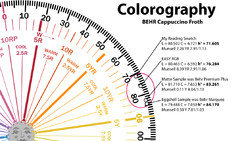
The colors are perceptibly within a tight range --- the front half of the yellow hue family, near the yellow-red hue family.Despite the different product and gloss levels, the color difference is a JND (just noticeable difference) just as the BEHR color experts predicted.
Meaning some people aren't going to notice a difference, won't care while a small percentage with more sensitive color acuity will notice it.
And, once again, none of this has anything to do with colorants, bases or formulas.
The comparison is based 100% on what the color looks like, how it's perceived by human eyeballs when it's cured and dry.
Jennifer Hogan
5 years agoLori, why are you compelled to prove someone else wrong?
I think you are selling people short when you say they can't see a difference between Yellow-Orange and Yellow. Fully saturated, I think almost anyone without full blown cataracts can see the difference between these 2 colors.

Less saturated the difference may become less discernible, but every woman over the age of 15 that I know has experience selecting foundation makeup, blush, lipstick and hair color. Why would we be less capable of seeing differences in wall color than we are at seeing differences in foundation powder colors?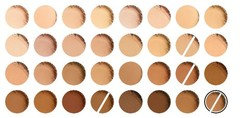
I stated clearly that the two samples were similar in hue and lightness (shade), but that the saturation was very different. One sample was far grayer than the other. Both samples were a great deal more yellow than the color identified through Easy RGB or through a measurement of the color of the paper sample.
When orange is desaturated it reads more purple gray, as yellow is desaturated it reads more green gray. Since I have teak wood (very orange) and my decor is mainly blue greens / teal, purples and wine reds the olive undertones look dead. I don't want purple walls, but am looking for a gray with the slightest bend toward purple.
That slight difference between the paper sample that is a true yellow orange would render similarly to the middle picture below while the actual samples are much more yellow and read closer to the first picture. If I go with a hue that is too orange I will end up with the third picture which will read purple/lilac on my walls.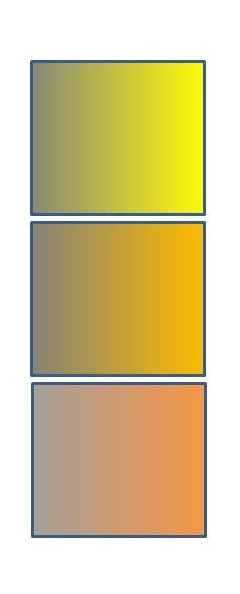
By the way - although these colors were rendered using a simple pallet of Microsoft Excel colors they still render something perfectly visible through the human eye. People print photographs from their computers with printers with only 3 colors and black ink and they render pretty well, so please stop telling everyone that the only value that has any meaning is the CIELAB. CIELAB is still measuring hue, saturation and light and converts to an HSL, RGB or Hex color code. Most computers can now render 16,777,216 different colors. Behr has 1434 colors in their Fan Deck.Computers will never be able to match the human eye in detecting colors, but they are good enough to make grandma happy when she views a picture of her grand baby.
Lori A. Sawaya
5 years agolast modified: 5 years agoI think you are selling people short when you say they can't see a difference between Yellow-Orange and Yellow.
I never said that nor did I imply it in any way whatsoever. Not even sure where or how you got that.
Lori, why are you compelled to prove someone else wrong?
I'm not out to prove you wrong, Jennifer.
I'm actually trying to help you.
You clearly have an interest and I'm willing to point you in the right direction.
There is no reason to get defensive.
You have some of the pieces of the color puzzle correct but not all of them.
Not only that, but other people read these threads.
Setting things straight, clearly spelling out how color works is not just for your benefit.
People print photographs from their computers with printers with only 3 colors and black ink and they render pretty well, so please stop telling everyone that the only value that has any meaning is the CIELAB. CIELAB is still measuring hue, saturation and light and converts to an HSL, RGB or Hex color code. Most computers can now render 16,777,216 different colors.
CIELAB is indeed the most useful set of data values for color.
It's right up there with XYZ Tristimulus values. And, yes, it is possible to transform those values to other formats including RGB, hex codes, etc.
CIELAB does not "measure" hue, saturation and light.
CIELAB doesn't actually even have a dimension of saturation or chroma.
Which is why we transform it to the more user-friendly LCh format.
L - Lightness, a* = redness/greeness, b* = blueness/yellowness. No chroma/saturation.
And, again, HSL, RGB, Hex Codes, anything to do with making or rendering color on a computer has nothing to do with how the human eyeball perceives color in real life.
It's two completely different color spaces - additive and subtractive color.
Your problem is you think you can toggle back and forth between the two and apply values where ever it seems convenient.
And it doesn't work that way.
You have to pick a lane. Additive or subtractive.
Which lane is the correct lane depends on the application.
The additive color space, which includes HSL, RGB, and hex codes, is not the correct color space for architectural coatings.
Those values do not define or describe how the human eye sees color. As a result, those values are not useful in helping us understand the color appearance of different paint colors.
Lori A. Sawaya
5 years agolast modified: 5 years agoI stated clearly that the two samples were similar in hue and lightness (shade), but that the saturation was very different. One sample was far grayer than the other.
There is a bit of a range but they're close - at least according to the data values you shared.
Chroma quantifies grayness and all the Chroma values are very close. I highlighted in blue the Chroma values in the LCh notations as well as the Munsell notations so you can compare them easily
These are the values you should be comparing to get a sense of grayness/clean/dirty. Don't use the "S" value from HSL.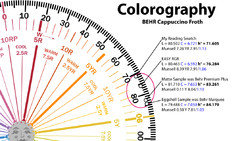
You can find LCh right below the CIELAB values on easyrgb. You want LCh(ab). There's another LCh but you don't want that one.
Both samples were a great deal more yellow than the color identified through Easy RGB or through a measurement of the color of the paper sample.Why do you think they were a "great deal more yellow"?
Emily Schlosser
4 years agoWowza. I was just curious what the prefixes mean in Behr paint, as Sherwin-Williams seemed to make more sense to me. I have no idea (or interest) in learning the finer details of color, but am curious why some colors start with an "N" or an "S" or "M".
skbryan
4 years agoCan anyone tell me if this formula is a shade of yellow? I think this is a behr formula from 2014, but not positive. Thanks.
Base 1050 Flat Matte
Premium Plus Flat Interior Paint
(adj) (CM) Customer color Match
CLRNT – OZ – 384th
B – 0 – 2
F – 0 – 0.5
T – 0 – 114
Paint sales at Home Depot
4 years ago
The dominant color is T, Medium Yellow at 114/384 ths of an ounce. Just a trace of Lamp Black and Red Oxide, B and F.Lori A. Sawaya
4 years agoskybryan,
Unless someone recognizes the formula and can associate it with a specific paint color, no one is going to be able to answer that question.
Because colorants and paint color formulas do not define or describe color appearance.Paint sales at Home Depot
4 years agosklbryan failed to state whether it was shot into a quart or a gallon. In a gallon it would be a very pale yellow. In a quart, considerable stronger., but yes, basically a soft yellow.
Paint sales at Home Depot
4 years agoLori,
The Behr color notations on their cards use the letters to indicate:
P Pure
M Muted
S Shaded
N Neutral
Becki Pope
3 years agoLori and Dave, I came on this site following a google search to find out what different codes on color chips mean. I have found your comments and your knowledge to be very helpful in understanding how paint chip colors can be affected by things other than environmental light, I am trying to select a paint color for my 3-season porch. I don't know much about color at all and may be as undecided as ever (lol), but have found the detailed information you have both provided to be educational and fascinating.
Lori, I don't feel you have been snide or elitist. You are right in saying that many people read this. Not all of us know much, if anything, about the science of color. I appreciate the time, attention, and detail that you have given to your comments. I work in the sciences so maybe I appreciate the "back story" more than some people might. Different strokes... :)
HU-12993671
2 years agoI read in the above, that the earlier colorants from Behr (Home Depot) did not have the “L” in the name. Or that the second "L” now used by all the colorants denotes that there are no VOCs. The names of the colorants except for the additional “L” seem to be mostly the same. Does the paint formulas remain the same across the VOC vs no VOC colorants. Or at least close? I am trying to reconstruct an old paint, the base is the same #.
Thanks
Paint sales at Home Depot
2 years agoAll the colorants remained the same as to hue and strength, except for blue, green, and to a lesser extent black. All the stock colors containing these colorants were reformulated. If you have a custom color using the old VOC green, blue or black, these formulas cannot be used. In this case, a new computer match would be necessary.
Faron79
2 years agoI'm in my FOURTH Colorant line in 20+ years now!
20 years ago-1) ACE Glycol-Based "Universal" Colorants.
2) Ralph-Lauren used some of Home-Depots Colorants. We used to have a Behr Line for the Independent-Retailer group.
3) Then....the switchover to ACE/Colortrend Low-VOC Colorants. Many Paint companies were switching-over to Zero/Low-VOC Colorants about 5 yrs ago. Our Ralph-Lauren line now required new Software for new ACE/Ralph-Lauren Formula-Book.
4) The SIXTEEN Colorants for C2! This required purchasing the big COROB D-600 Tinter, which was $16,000 back in 2006. This was quite the Colorant line! High & Low-strength Blacks...High-Blue & Low-Blue, 2 Yellows, 2 Reds........etc.
5) And now.....BM GENNEX 0-VOC Colorants!!* Weird Letter & Number designations now!
* "S1" = Black....B1 = Blue....Y3 = Yellow-Oxide..............................
* There's THREE Yellows & THREE Reds, NO Raw-Umber Tone, and a seldom-used "O1" Orange.
* It's SO weird not having an "L" Brown/Raw-Umber, or an "I" Brown-Oxide anymore!!
Last March/April 2020, Ben-Moore entered into ACE's retail-channel Nationwide. They paid for hundreds of ACE retailers' "Tinter-Flushes". Our big COROB D-600 took 2 days to flush out the Colorant-cannisters, pumps, valves, & all the supply/return lines! Then.....a half-day to Calibrate!
In Spring 2021....we had to get a NEW Tinter. Our 15 yr-old COROB was getting too expensive to keep calibrated. So....they let me spend $20,000 on another COROB!!! Made in Italy, down the road from Maranello (Ferrari!!). Had to wait 2 excruciating months, but she finally arrived!!
Now-I've the new BM Gennex Colorant sitting in a new $20K D-600 COROB, using 13 of the 16 available 6 Qt. "Cylinders". ;-)
>>>> Why did I babble all this?!Because- Colorants are SO different out there, & they've changed A LOT.
"Color" (more precisely, PERCEIVED Color....) is a moving target. The color on your walls ISN'T the same as it was 20 years ago anyway! Nobody seems to realize this..... I won't mention what our HAIR color does.....
>>>> So- when someone mentions they want to "recreate an old color"........ I kinda smile...... "a little"...... ;-)
FaronLori A. Sawaya
2 years agoWhat never changes is a color's CIELAB values. Further emphasizing my point that chasing colorants/formulas is ineffective and pointless.
Paint sales at Home Depot
2 years agoFaron, HD has been fairly staid compared to you. Other than changing to no VOC and adding two colors, a high hide, fade resistant yellow and a violet tint, we haven't changed much. We did change to a full ounce and 384ths measurement, which is really the same, as 48ths and 96ths are devisible into 384.
A bonus with the new no VOC tints is that they dry much faster than the old glycol based tints, especially with those dark colors with mega ounces of tint! It does, however, make maintenance of the machines a little harder.
I am on my third generation of tint machines in 16 years . They have gotten more accurate and have more features such as touch screens and scan guns. I will say that HD does not hesitate to spend money on technology if it thinks it will up production and lessen goofs.
Jennifer Hogan
2 years ago@HU-12993671 - Do you have a sample of the color or just the old formula? Is your formula on a can lid with paint on the back side? Color sitting on your wall for 10 years may not match what was in the can 10 years ago, so you have to decide which color you want - the sun damaged, environment damaged wall color or the protected color from the inside of the can.
Without a sample of the color there are several complicating factors.
One - As others have pointed out the colorants do change, so the same formula may not produce the same color.
Two - our memories are not Memorex. Sometimes we remember a room or a color differently than what it was. My sister gave me a crewel embroidery piece that my mother had made and had hanging in her bedroom. I didn't remember the beiges being so yellow beige, I thought it was much more neutral, but colors then often leaned brown/yellow beige. (Think Harvest Gold / Olive Green). We were used to seeing those colors and now we are more accustomed to seeing much more subdued colors, so these colors stand out as different.
Three - colors look different in every environment. The colors paired with a color changes our perception of color and light changes our perception of color. Lighting has changed quite a bit over the past 10-15 years.
Can you provide some additional information so we can help you achieve your objective?HU-12993671
2 years agoSorry about the delay in answering, it has been a long couple of weeks.
I used semi-transparent concrete paint on a basement floor. Every 5 years or so I need to touch up the rough spots. The paint I have been using consists of 4 colors, in quart paint cans. I was going to do touch up this month and discovered the cans had rusted through and dried out.
I do have the formulas on the top of the cans. The cans came from 1 gallon of base, divided into 4 quarts with formulas added. The formula labels are listed on top, as per gallon but I suspect the values are per quart. The reason I suspect this, is that I went to Home Depot and asked what the formulations are for 4 similar paint colors that are currently available, in the same semi-transparent paint base. They gave me the four outputs and the black paint per gallon is pretty much correct if you divide by 4. The two blacks that matched are "Arctic Black" and “Dark Coal”. The others are not the correct colors just in the general range of the originals.
As to the above answers and suggestions; the 4 colors are black, yellow and two reds so the colorants are probably close to the same. I took a look at the hockey pucks in the bottom of the cans but they seem to be layers of colors so I assume the paint settled out by weight. The paint dabs on the top of the cans are not in good enough shape to scan. But the paint on the bottom of the lids do look scannable (thanks for the suggestion). The question becomes how to translate the scans into a semi-transparent paint. I am thinking of asking for a scan of the lids and then trying to match up the numbers, using a scaling factor to get the numbers close to the originals.
And thanks for the replies. I have received much more useful information than I expected.
Thoughts? Suggestions?
Thanks.Nick D
2 years agoI'm trying to match an older paint that Home Depot mixed for me. It is a Behr Premium Plus Ultra, Medium Base. But the colorant codes on the can are no longer used at Home Depot. I noticed the Behr Colorant codes listed above and even though that post is from 3 years ago, those codes are different than what I have on the can from 2010.
The codes on my can are:
CLRNT – OZ – 384thB – 0 – 164
C – 0 – 180
V – 0 – 188
Would these cross-reference to the new codes as:
B = BL = Lamp Black
C = CL = Yellow Oxide
V = VL = Quinacridone Violet
Or, do the old codes refer to completly different tints.
Any help would be appreciated. Thanks.Paint sales at Home Depot
2 years agolast modified: 2 years agoThe new codes with the "L" after them are the newer No VOC colorants. When they were introduced, most of the colorants except EL and DL remained the same. However, the new Blue (EL) and Green (DL) are much stronger. To a lesser extent, the Black (BL) became slightly stronger. Your old code should produce a very close facsimile as it contains no Blue or Green. I don't believe the Black BL will pull it of significantly. Your local Home Depot should be able to recreate your paint from this formula.
Also, all the existing Behr and Glidden standard colors were reformulated at that time. If you know the name of the color, the new formula will come up automatically in the computer.
Nick D
2 years agoThanks so much, David. The original paint that I purchased was in fact a standard color, sort of a tan/linen color. Two weeks later when I ordered more to finish the project, the standard color was no longer standard and they said they had to color match. Maybe this formula is the result of them looking up the old standard color. But, I didn't think to write down the original standard color name before i tossed the paint can. I take photos of all formula tags on my paint cans and I also store a paint stick with each color painted on it, mfg and full description and room where used - everything but the original standard name. Ha. Thanks!
Faron79
2 years agoMost ACE stores are now tinting with BM Colorants. Couple years ago, BM started pushing their way into ACE's nationwide.
Up in Fargo, we got converted in April 2020. So NOW..... we're shooting ACE C+K, Ben-Moore, & Magnolia......with BM Colorants!!
There's more wrinkles out there than you realize!🤓🤓
FaronPaint sales at Home Depot
2 years agoWell, I work in the real world of everyday homeowner paint problems. Doing paint forensics is part of my job. I have been at Home Depot paint for 16 yeas now, after 4 decades of real world paint contracting. I am aware of how Behr has evolved over these 16 years and how to make a reasonable facsimile of a customers paint when they come in with some data missing.
Fortunately, I no longer have to deal with egotistical interior decorator/ designers trying to justify their fees to the homeowner. I do know that I have many customers who state, " I only come in when I know you are on duty". Yes, it does stoke my ego and make me want to keep working when , at 78, I could just sit back in a rocking chair. In reality, I don't do idleness well and plan on doing this as long as I am physically and mentally able.K Shapiro
2 years agolast modified: 2 years agoAfter reading this thread I decided that more than 8 crayolas are too many.
Matt Tabakman
last yearHere’s hoping one of the experts still check this old board. I picked up a gallon of Agreeable Gray from Home Depot recently - Behr Premium Plus flat (asked for it just like that). My aim was to do some touch ups, and the 4 year old can in the garage had dried up. Opened new can, stirred, rolled it on, let it dry….it’s noticeably lighter than the paint on the wall. Same color, same base, brand, sheen. Looking at the labels this morning, I notice that the color codes are different, though. So, could this be the issue? Could the formula have changed in 4 years? Did the employee goof? Something I did? See photos below. Wondering if I brought this photo in if I could get the right color - unfortunately I don’t have that Can anymore, so one of the codes is forever covered by some paint lol. Constructive advice appreciated!
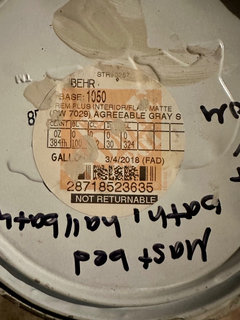
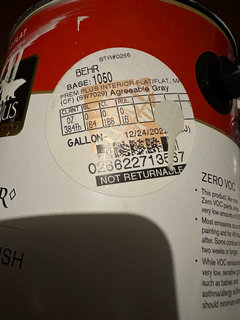
Paint sales at Home Depot
last yearYour local HD should be able to duplicate the formula exactly from the serial number on the bottom of the round label. An experienced associate should have caught this error - I would have! There would be no charge for a new can of paint.
Matt Tabakman
last yearTo be fair, I didn’t bring a photo of the label with me when buying the new can. Somehow I figured asking for the same color using the same paint base and sheen would give me the same result. But with your advice, I know my next step - thank you so much!
Susan
last monthHope PRO is still out there!
I painted my livingroom in 2011. Today I want to paint my whole house the same color. The round label on my BEHR paint was faded. However by taking a picture with my IPAD, enlarging it, and using a magnifying glass I was able to copy it. I took my written out copy and my IPAD to HD. The associate was only interested in the picture on my IPAD and did’nt even look at what I had written out. She keyed something into the computer which heaven only knows she must have had radar eyes. The old label and the new label are not the same. The color is close but the original color was more green aqua and the new mix is more blue. It is really bugging me. I’ve painted some walls and it just looks so much bluer to me. Is the ”C” on my old label the same as the ”CL” (yellow oxide) that they use now? And if I take only my written out copy of my old label is an associate able to mix paint with only that? Thanks . Any advice will be appreciated.
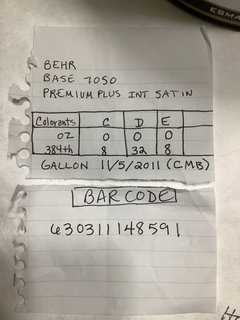
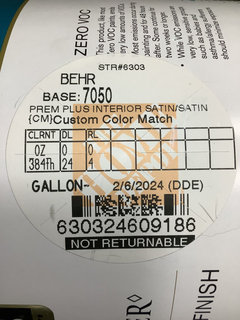
Paint sales at Home Depot
last monthlast modified: last monthHome Depot cannot directly use your old formula as it used the old high voc tints. The newer no-voc tints in the D (green) and E ( blue) are much stronger, which should make it considerable more green/blue. Probably more to the green side as there is 4 times as much green in the formula as blue.
I color match on the computer would be the most immediate answer to getting a reasonable facsimile. Barring that, the HD associate might try reducing the formula's blue and green by about 20%.
Susan
last monthThank you for your help. It is just hard for me to understand how the paint I bought in 2011 had thalo green, thalo blue, and yellow oxide in it to make the color I picked out and now the new can I just bought has only thalo green and permanent red in it and is suppose to be a match. To color match do I just take some of my old paint and paint it on something? If so what is the best type of surface to paint it on to get the best match?
Paint sales at Home Depot
last monthIf the old paint is still good, it makes a good sample. Your local HD associate can dry a sample from the paint. Sometimes, enough paint has dried on the side of the can, that a sample may be cut from the label.
Faron79
last monthSome companies Colorant lines have changed a couple times over the last 10 years!
*Hardly anybody knows about C2 paint. They used a total of 16 Colorants. Some formulas had up to EIGHT Colorants!
* Glycol-based colorants were the mainstay for a looooonng time, before the VOC regulations hit.
* BOTH Latexes & Oils could be tinted with Glycols.
* Everything now is Low/0 voc colorant.
PLUS......what nobody seems to realize anymore......the color on their walls technically isn't the same as 10+ years ago either!
FaronJ
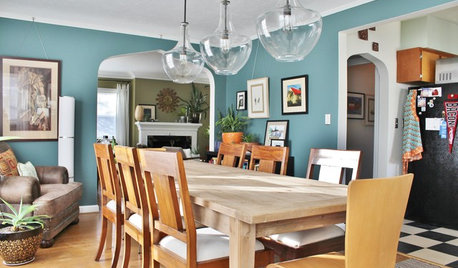
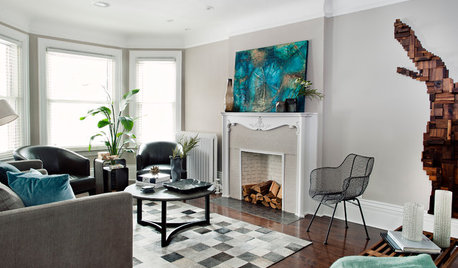
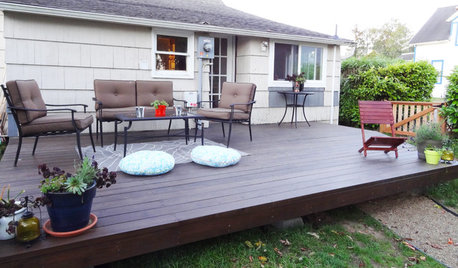
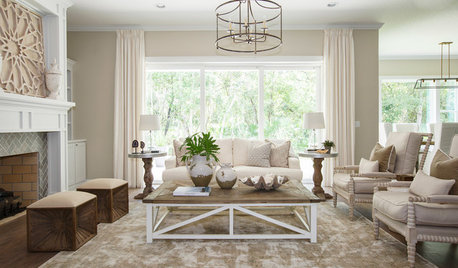

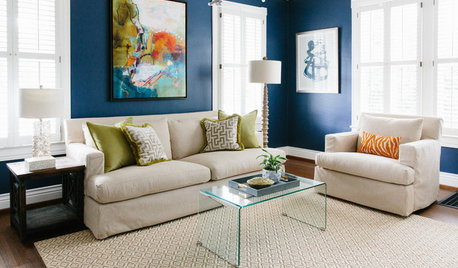
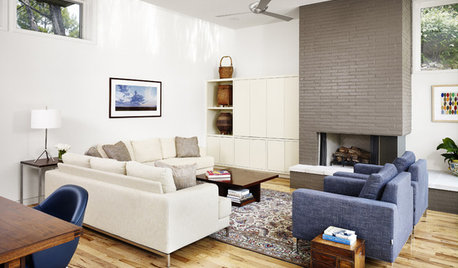
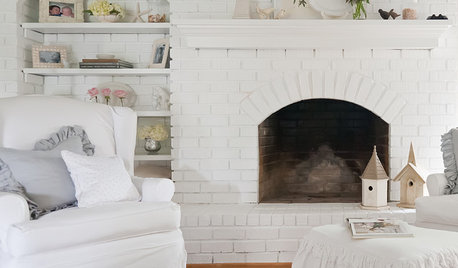
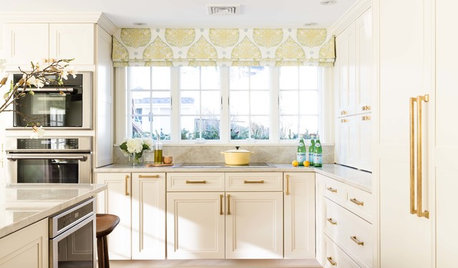




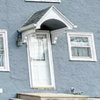

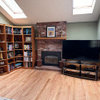
Paint sales at Home Depot